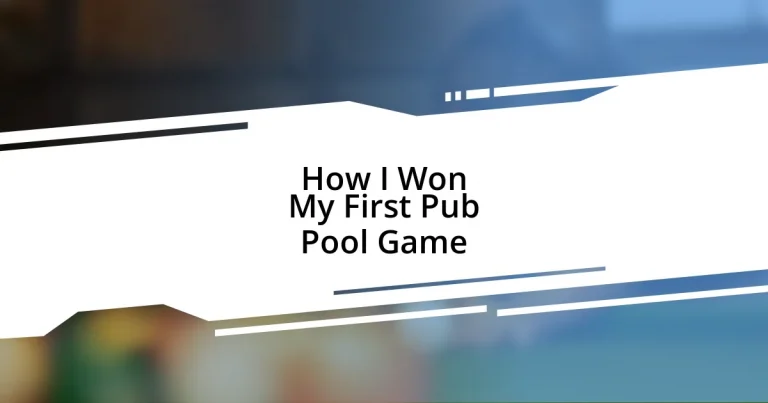Key takeaways:
- The winner in pub pool is the first player to legally sink all their designated balls followed by the eight-ball.
- Choosing the right cue affects shot accuracy; factors include material, weight, and tip size.
- Mastering stance, grip, and aiming techniques significantly enhances shot accuracy.
- Psychological tactics, observing opponents, and unpredictability are key strategies for outplaying competitors.

Understanding Pub Pool Basics
Pub pool is a game that’s not just about sinking balls; it encompasses strategy, skill, and a fair bit of luck. I remember walking into my local pub and feeling a rush of excitement mixed with nerves as I picked up the cue for the first time. The simple act of aiming for that beautifully arranged triangle of balls felt like it held the promise of a thrilling experience.
Understanding the basic rules is crucial to enjoying the game. For instance, did you know that in pub pool, the winner is typically the first player to legally sink all their designated balls, followed by the eight-ball? I vividly recall my first experience when I accidentally put the eight-ball in too soon. The immediate gasp from my friends made my heart race; it was a classic rookie mistake that left me more eager to learn than embarrassed.
The environment of a pub offers a unique twist to the game, with laughter, friendly banter, and the clinking of glasses all around. There’s something about the camaraderie in the air that made my initial game memorable. Isn’t it fascinating how a simple game of pool can turn into a social event? Every shot taken, and every laughter shared adds an extra layer to the experience beyond just playing the game.

Choosing the Right Cue
Choosing the right cue can significantly influence your performance at the pool table. When I first started, I didn’t realize how much a well-fitted cue could improve my shot accuracy. The balance and weight made a noticeable difference in how my strokes felt and that moment of sinking my first shot with a cue that felt just right was exhilarating.
Different cues serve various purposes, and it’s worth spending some time considering factors like material, weight, and tip size. I once picked up a friend’s lightweight cue, and while it felt a bit flimsy in my hands, I mistakenly thought it would help me make quicker shots. Instead, I ended up with more missed opportunities than I’d like to admit. That experience taught me that heavier cues often provide better control for my playing style, as long as I maintain a steady stroke.
When I made the decision to invest in my first cue, it felt like a rite of passage. I went to a local pool shop, eager but a bit overwhelmed. I soon learned that spending some time with different cues made a world of difference. It was as if I was trying on a pair of shoes – once I found the right one, the game became so much more enjoyable.
| Factor | Consideration |
|---|---|
| Material | Wood options like maple and ash provide different feels and levels of control. |
| Weight | Heavier cues (19-21 oz) are often preferred for better stability. |
| Tip Size | Tips can vary from 12 to 14 mm affecting the grip on the ball. |

Techniques for Accurate Shots
Mastering accurate shots often comes down to your stance and grip. I remember the day I discovered how a proper stance could dramatically change my game. I used to overthink my positioning, but once I found my balance, it felt like a weight lifted off my shoulders. Standing with my feet shoulder-width apart allowed me to feel grounded and stable, which in turn gave me the confidence to focus on making the shot rather than worrying about slipping.
To enhance your shot accuracy, consider these key techniques:
- **Proper Stance:** Position your feet firmly, with the non-dominant foot slightly forward.
- **Solid Grip:** Hold the cue firmly but not so tight that it restricts your natural stroke.
- **Stability:** Keep your elbow steady and aligned with the cue for consistent aim.
One of the most transformative moments in my pub pool journey was when I learned the importance of aiming. Initially, I shot the cue ball without a clear target in mind, which led to countless misfires. I’ll never forget the first time I focused on the contact point with the object ball. It suddenly felt like magic – sinking that shot gave me a rush I still chase today. It’s not just about hitting the ball; it’s about visualizing the path it will take post-impact.
To refine your aiming technique, keep these tips in mind:
- **Visualize the Path:** Imagine where the object ball needs to go and how the cue ball will impact it.
- **Focus on the Contact Point:** Aim for the precise spot on the object ball to execute your target shot.
- **Practice Consistently:** Regular practice helps solidify your aiming instincts, making them second nature.

Reading the Table and Angles
When I’m at the pool table, one of the first things I do is take a moment to really read the layout. Have you ever stood in front of a table and felt overwhelmed by all the angles? I certainly have. Initially, I would just rush in without considering how the balls were positioned. But after a few games, I realized that which balls are clustered or isolated can make a huge difference in strategizing my shots.
Understanding the angles transformed my game in ways I hadn’t expected. I remember one particular match where I was stuck, eyeing two balls in a tricky corner. I mustered the courage to analyze their relationship, thinking about where I could strike the cue ball to pocket one of them. It was like solving a puzzle; once I broke it down, I felt a surge of confidence. Suddenly, it wasn’t just about hitting balls; it was about setting myself up for future shots.
The key is to visualize the trajectory of the cue ball after impact. Can you picture it rolling to the next target? I’ve learned that imagining where each ball will end up can drastically shift my approach. In one memorable game, I aimed for a difficult cut shot, but instead of panicking, I took a deep breath and visualized the angle. I executed the shot perfectly, sinking the ball and leaving the cue ball in an ideal position for my next play. That’s when I fully understood the rhythm of the game; it’s a dance of angles and anticipation.

Strategies to Outplay Opponents
One of the most effective strategies I adopted to outplay my opponents was mastering the mental side of the game. It might sound cliché, but psychological tactics can be just as important as skill. I remember a moment when I locked eyes with an opponent who seemed confident, but I focused on maintaining my composure. By projecting calmness and confidence, I could see that my opponent began to second-guess their own shots. Have you noticed how a little mental pressure can sway a game?
Another key strategy I’ve found invaluable is to watch and learn from my opponents’ habits. Early on, I would often overlook this, but now, I keenly observe how they line up their shots and their preferred angles. There was a time I played against a player who favored certain pockets, and by noticing that tendency, I positioned my own shots to block those options. It felt like I was playing chess rather than pool, slowly unraveling their strategy while crafting my own.
Finally, don’t underestimate the power of unpredictability. I recall a critical game where I decided to mix up my shot selection instead of sticking to my usual playstyle. I went for unexpected bank shots and tricky spins—moves I had been practicing but rarely used. The exhilaration of surprising my opponent was exhilarating! Have you ever felt that thrill when you successfully execute a shot that others wouldn’t dare to attempt? It often puts your opponent on the back foot, forcing them to rethink their strategy.

Handling Pressure During the Game
I’ve come to realize that handling pressure during a pub pool game is as much about mindset as it is about skill. One evening, I was in a tight match, and I felt my heart race as the final shot loomed. In that moment, instead of succumbing to the anxiety, I closed my eyes, took a deep breath, and reminded myself of all the hours I had spent practicing. It’s amazing how shifting your focus from the outcome to the process can ground you and improve your performance.
Navigating the pressure also involves maintaining a calm demeanor. I remember one nail-biting game where I was down to the last ball, and my opponent was visibly confident. Instead of letting their energy overwhelm me, I focused on my breathing and kept a slight smile on my face. Have you noticed how a simple smile can change the atmosphere? It not only calmed my nerves but also created a moment of doubt in my opponent’s mind. Such tactics can be game-changers.
Additionally, there’s something about the crowd’s energy that can amplify pressure. During one intense round, I could feel everyone’s eyes on me, waiting for my next move. In that scenario, I chose to pause. I glanced around at my friends, saw their encouraging smiles, and let that support fuel me. I think it’s crucial to remember that the audience is rooting for you rather than against you. Those moments of connection can often be just enough to regain control over your emotions and focus back on the game.














